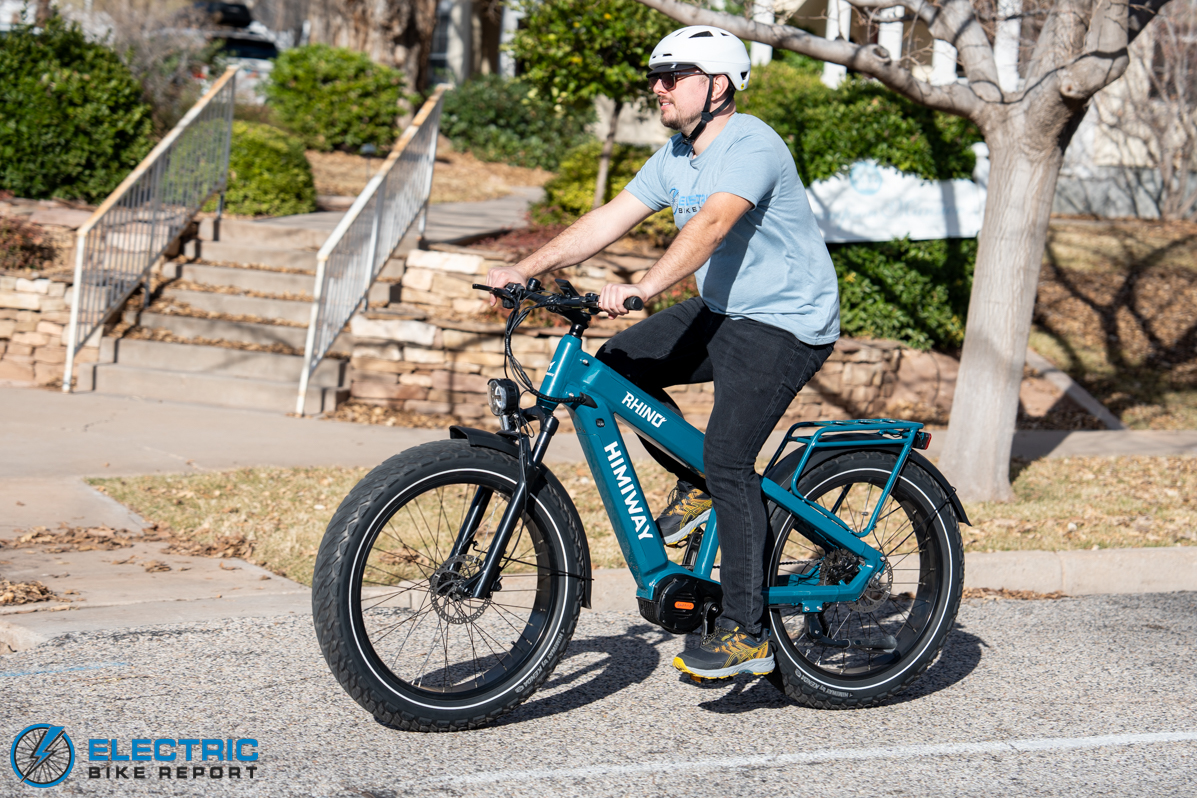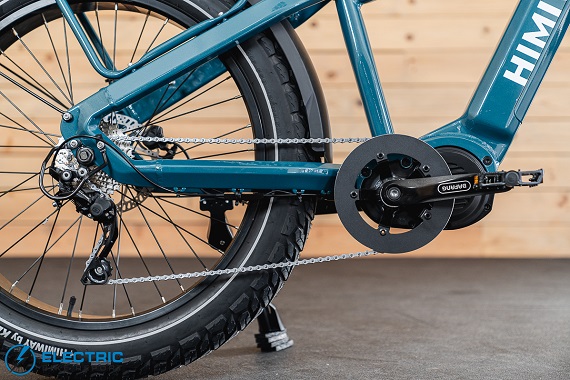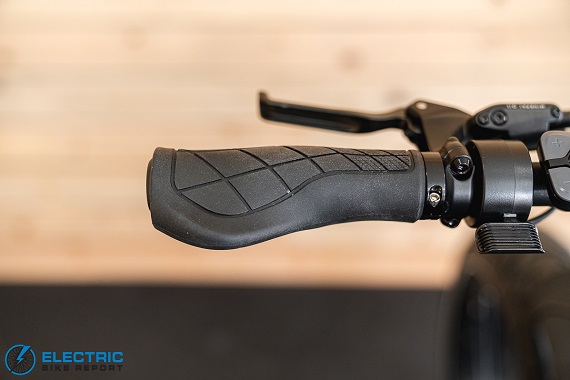Bebopping with Rocksteady: This Huge and Heavy Commuter Boasts Heaps of Power and Long Range Potential

Here at Electric Bike Report, we often hear prospective and current e-bike owners wishing for the ability to cover more miles on a single charge. With the D5 Ultra, Himiway responded to these appeals by including TWO 48V, 720 watt-hour (Wh) batteries. This adds to the bike’s overall size and weight, but with a total of 1440 Wh of capacity, also greatly extends its range; we were extremely satisfied with the bike’s performance in our Range Test.
The Rhino’s size was perhaps its most immediately obvious feature, including its massive 26”x4.5” tires. It felt like a tank – and it weighed a jaw-dropping 104 lbs! The upside of the D5 Ultra’s size, weight, and super-wide tires was that it felt remarkably stable and solid while riding.
We also enjoyed a high degree of visibility from the bike’s high riding position. Its wide, cushy saddle and ergonomic rubber grips added to the overall comfort. We found its riding position and comfort level to be appropriate for the long-distance rides its dual batteries are capable of.
For all the D5 Ultra did right, it had a few areas with room for improvement. For example, the entry-level brakes performed fine, but such a large bike would benefit from an upgraded brake set. Additionally, the 1,000W mid-drive motor could be punchy, but accessing its full power wasn’t as easy as we expected. We’ll explore the details later in this Himiway D5 Ultra review; continue reading below for the results of our Speed, Range, Hill, and Brake Tests!
Sponsor
Bike Category:Fat Tire/Commuter
Class 2 E-Bike:Throttle and pedal assist up to 20 mph
Sponsor
Himiway D5 Ultra Video Review
ELECTRICAL SPECS & FEATURES
Battery:Dual 48V 15Ah (720 Wh) LG lithium battery Display: LCD display with USB charging Motor: 1000W Bafang M620 Mid-drive Motor Controller: 48V/25A Headlight:48V LED light Taillights:Integrated taillight Pedal Assist: ECO/TURBO PAS 0-5, Torque Sensor Range: 100 miles Throttle:Thumb throttle UL Certification:Coming soonWeight & Dimensions
Claimed weight: 97 lb. Rider height range: 5’3″ ~ 6’4″ Maximum load on the rear rack: 33 lbs Total payload capacity: 400lbsComponents & Accessories
Brakes:Tektro 180MM hydraulic brakes Fenders: Plastic, front and rear Fork: Alloy front suspension fork with lockout and adjustment Frame: Upgraded 6061 aluminum Drivetrain: 9-Speed Shimano, 13-32T Grips: Ergonomic Rubber Saddle: Selle Royal Handlebar: 780mm Kickstand: Heavy duty aluminum Pedals: Alloy pedal with reflectors Tires: 26″ x 4.5″ Kenda×Himiway fat tires
We liked the stability that came from the bike’s hefty frame and tires, but it wasn’t the most agile of e-bikes.

The top tube and down tube each host a 48V, 720 Wh battery, but they blend in well.

The massive 4.5”-wide fat tires roll relatively smoothly with low-profile street tread.
The Himiway D5 Ultra performed well in our Speed Test, though we found that there did not seem to be any obvious differences between its two riding modes. I tested each of its five pedal assist system (PAS) settings in both its Eco and Sport modes as I pedaled along a flat segment of the local bike paths.
I recorded my maximum speed in each setting to gain an understanding of the bike’s programming and motor performance. My expectations were fairly high, considering that the Rhino features a 1,000-watt mid-drive motor. We have tested a handful of e-bikes with this motor in the past, though its performance on the D5 proved to be somewhat different.
Beginning with the PAS deactivated (PAS 0), I pedaled the bike solely by my own power. I anticipated a good workout considering the bike’s weight, but I found that the 10-speed Shimano Deore drivetrain had a wide enough gearing range to make the job relatively comfortable. My maximum speed to start was 11.3 miles per hour.
In Eco Mode, even the lowest PAS setting packed some serious punch; activating the motor carried me to 16.2 mph. As I progressed through the higher settings, my speed increased steadily to 17.5 mph in PAS 2, 18.5 mph in PAS 3, 19.1 mph in PAS 4, and 20.1 mph in PAS 5.
Sponsor

The bike’s pedal assist levels felt relatively reserved, but the throttle packed much more punch.

The bike’s gearing felt dialed in for its weight and Class 2 speed limit of 20 mph.

The 1000W Bafang M420 motor can produce a maximum of 160 Nm of torque.
There did seem to be a slight difference in feel between Eco and Sport modes; it felt as though the motor’s output varied more in the former and stayed more consistent in the latter. This resulted in a somewhat jerky feel in Eco, while Sport helped to smooth out the ride.
Riding modes aside, the D5 Ultra’s pedal assist system showed a steady increase in power between its low and high settings. We generally find this sort of pattern to be ideal, as it makes the differences between settings feel intuitive. With the Rhino’s Class 2 speed limit of 20 mph and the strong start from PAS 1, the differences between settings felt relatively minimal.
I found that the bike felt relatively reserved when pedaling, but far punchier and more powerful when using the throttle. The full power of the bike’s 1,000W mid-drive seemed to be unleashed when throttling, providing faster acceleration and a thrilling ride.
As we expected with the Rhino’s dual batteries, the bike covered an impressive distance in our Range Tests! We determined two bookend range values by riding it in Eco mode/PAS 1 and Sport Mode/PAS 5 until one battery was depleted, then doubling the distance we measured when tracking our ride in Strava.
With the maximum amount of pedal assist in Sport/PAS 5, we covered 30.8 miles in 2 hours and 5 minutes. When doubled, our results suggest a low-end ballpark of 61.6 miles and the ability to travel 4 hours and 10 minutes.
On the high end, we measured a distance of 51.6 miles over 3 hours and 45 minutes when riding in Eco/PAS 1. When doubled, these figures indicate that the bike could have traveled 103.2 miles in 7 hours and 30 minutes when using both batteries.
E-bikes with more than a single battery are still relatively uncommon; as such, this is the first e-bike of its kind (a fat tire commuter) that has traveled such a great distance on a single charge! With a highly practical amount of speed in its lowest PAS setting, there is a significant payoff for choosing to ride in PAS 1.
When comparing our estimated range (based on motor and battery specs) to our real-world test results, we can see that the Rhino’s motor is surprisingly efficient. With its 1,000W motor and total battery capacity of 1,440 Wh, we expected the bike’s Sport/PAS 5 test to yield roughly 21 miles in 1 hour and 26 minutes. The test’s final mileage and time both showed nearly a 200% increase over our estimated results.
We expect that some of the D5 Ultra’s efficiency is due to the fact that it uses a mid-drive motor, which requires some degree of input from the rider. I believe that a greater factor is the bike’s programming; it seemed to require an unusual amount of force on the pedals before the motor would let loose its full force.
In truth, only a handful of bikes we have tested have exceeded the 100-mile mark. We were pleased both by the D5 Ultra’s performance in this test, as well as the fact that our results met and exceed Himiway’s advertised range of 100 miles. With the ability to travel so many miles, we think it’s clear that the bike is well suited to its role as a commuter
Sponsor
We first tested the bike’s throttle power; as expected for a 1000W motor, the bike rocketed to the top of the hill in 66 seconds with an average speed of 16.4 miles per hour. This placed it among the fastest 10 e-bikes we have reviewed (out of literally hundreds), proving that there is little that can pose a challenge to such a powerful bike.
Our experience when pedaling was somewhat less groundbreaking; our test rider Justin pedaled in PAS 5 and reached the top of the path in 2 minutes and 3 seconds. The bike moved significantly slower with an average speed of 8.8 miles per hour.
This test was performed with the bike in Eco Mode, though as referenced in the Speed Test section of this Himiway D5 Ultra review, there seemed to be little observable difference between Eco and Sport. To verify that finding, we performed a secondary Hill Test at a slightly less extreme location near the EBR office. Between Eco/PAS 5 and Sport/PAS 5, we measured only one second and 0.2 mph of difference between the two tests.
E-bikes with mid-drive motors often complete this test faster when employing their throttle, but there is not usually such a large difference (nearly a minute) between their results.
When compared to similar e-bikes we have tested – primarily of the all-terrain variety – the D5 Ultra’s pedal test results were among the slowest we have seen from a mid-drive. We attribute this to the uncommon characteristics of its motor I mentioned previously. Most of the time, the Rhino seemed to deliver a more conservative level of power than average, and it seemed far less inclined to dispense its maximum output except when pedaling with significant effort.
Our test results show that the bike has plenty of power to be able to climb hills – but the throttle is likely to be best for riders who want to do the job quickly and easily.
Sponsor

We liked the “Midnight Forest” paint job and the overall styling of the bike.

Users can swap between Eco and Sport modes by holding the ‘+’ button on the control panel.

The bike includes Tektro E350 hydraulic disc brakes with 2-piston calipers and 180mm rotors.

The D5 Ultra is equipped with a decent brake system, but its weight proved to be a disadvantage in this test. With three sets of measurements from the performance of its Tektro HD-E350 hydraulic disc brakes, we calculated the bike’s average stopping distance to be 26’9”.
Comparing the D5 Ultra to similar e-bikes is relatively difficult due to its weight and size; most of the fat tire e-bikes we have tested weighed significantly less. Larger, heavier, all-terrain e-bikes make for a more fair comparison, though as a commuter-style fat bike, the Rhino is intended for a completely different purpose. Regardless, the average for this more adventurous category of e-bikes is 24’4”, showing that the D5 Ultra’s stopping distance was nearly 2 and a half feet beyond the average when compared to bikes with similar weight.
The bike’s E350 brake system uses two-piston calipers paired with 180 mm rotors. This system is specifically rated for e-bikes, and as such, makes regular appearances on models of all shapes, sizes, and varieties that we have reviewed. Its performance has varied greatly between decent and excellent, though it often performs best on e-bikes that weigh roughly half of the Rhino’s heft.
My personal testing reinforced our test results; the D5 Ultra’s brakes felt responsive, but the bike’s inertia overcame their power. This led to an extended slowing down/stopping experience that felt safe but took longer than expected.
As such, we recommend that Himiway upgrade the currently-equipped two-piston brake system to a more powerful 4-piston setup on the next iteration of the bike that would help offset the Rhino’s weight. Current/future owners should not be concerned about rushing to upgrade the E350 system, but we advise giving yourself more room and time than you might initially expect for the bike to stop.

The 710mm handlebars felt appropriate for the bike, with good stability and control.

The tail light bears Himiway’s logo and functions as a brake light when the levers are squeezed.

The Rhino’s 500 lumen headlight is large and impressively bright.

The air fork has 85mm of travel and a lockout.
Himiway offers the Rhino in a single frame size advertised to fit riders from 5’3” to 6’4”, with most of its adjustability being in the seatpost length for 7.5” of adjustment in saddle height. Considering the bike’s extended wheelbase and massive tires, we were skeptical of its ability to fit shorter riders, but our tester Kaleigh who is 5’4” found a comfortable fit. At 5’11”, I was much more firmly in the middle of the bike’s height range. I also enjoyed its fit and feel – plus there was still some room in the saddle height for taller riders.
As I mentioned previously in this Himiway D5 Ultra review, comfort was a highlight from my time on the bike. In particular, the wide saddle was something I would have expected more on a relaxing cruiser-style e-bike, and I thought it greatly enhanced the quality of the ride.
In terms of handling, the Rhino responded well but it certainly felt its size; its long wheelbase made for relatively wide turns. I liked the stability and steering control from the 710mm handlebars, and the motor’s power helped to offset the bike’s weight to some degree, but it was noticeable regardless.
I mentioned the differences in feel between Eco and Sport modes, but I also want to highlight the motor’s gear sensor, which is a welcome addition to such a powerful bike. During previous testing of some other e-bikes with extremely torquey mid-drives, we observed premature wear on their cassettes. The Rhino’s gear sensor cuts the motor’s output when shifting, which helps to protect the drivetrain from such massive forces.
Sponsor

The bike’s color display is made by Bafang, with well-organized presentation of ride info.

The wide, plush saddle was undoubtedly a highlight of the ride!

We liked the squishy and accommodating ergonomic rubber grips.

Our contact at Himiway advised us that the rack’s capacity is 15 kg/33 lbs.
Second, the bike includes two batteries, but only a single charger that connects to one battery at a time. We were happy to see that Himiway included a 3-amp charger with the ability to top up one of the 15 Ah batteries in 5 hours, but we would prefer the ability to plug both batteries in at the same time. As such, we recommend purchasing an additional charger before checking out.
The final point of critique that I have is regarding the D5 Ultra’s Eco and Sport modes. I appreciated having what was intended to be both a low and high power riding mode, but the bike’s performance showed little discernible difference between the two. We hope to see a noticeable difference in programming between the modes on the next iteration of the bike – or at least a condensed system with a single riding mode.
To be clear, I think the Rhino generally functioned well. I appreciated its wide gearing range and smooth shifting, its overall power and speed, and its robust, stable feel. I found it comfortable to ride, and I had a great time when throttling around with full power.
The Rhino’s range capabilities stood out from many of its other test results as a highlight. With a demonstrated ability to cover 100+ miles on a single charge of its dual batteries, we think commuters and weekend adventurers will find much to appreciate.
Prospective buyers should be aware of the bike’s size and the tradeoffs that come with its remarkable plantedness and stability. In particular, we hope to see a more powerful braking system on the next version of the bike to offset its significant inertia. Additionally, it would benefit from a few other minor quality of life improvements – but we have to give kudos to Himiway for trying something new. A massive, commuter-style fat-tire e-bike with dual batteries is not something we’ve ever quite seen before!
Bottom line: if range anxiety keeps you up at night and you are drawn in by the thought of pedaling an e-bike that feels powerful and indestructible – the Himiway D5 Ultra might just be the bike for you.
Happy Riding! Make sure to let us know if you have any questions or if you think we left anything out in this review of the Himiway D5 Ultra down in our comments section.
Sponsor
Sponsor
Copyright
© Electric Bike Report


